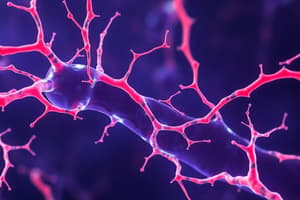Podcast
Questions and Answers
What does grey matter in the brain contain?
What does grey matter in the brain contain?
- Neuronal axons and glial cells
- Myelinated axons only
- White blood cells
- Neuronal cell bodies, unmyelinated axons, dendrites (correct)
Where is grey matter located in the cerebrum?
Where is grey matter located in the cerebrum?
- Deep down
- Around the spinal cord
- In the white matter
- Superficially (correct)
What is the function of white matter in the brain?
What is the function of white matter in the brain?
- Contains neuronal cell bodies
- Increases the surface area of the brain
- Connects areas of grey matter to each other (correct)
- Stores memories
What are the folds of the cerebral cortex called?
What are the folds of the cerebral cortex called?
In what part of the brain does white matter lie?
In what part of the brain does white matter lie?
What is the main function of grey matter in the spinal cord?
What is the main function of grey matter in the spinal cord?
Which part of the brain contains myelinated axons connecting different areas?
Which part of the brain contains myelinated axons connecting different areas?
What structures are found in grey matter of the cerebrum?
What structures are found in grey matter of the cerebrum?
What is the main role of white matter in the brain?
What is the main role of white matter in the brain?
Which would you find in grey matter?
Which would you find in grey matter?
Study Notes
Functional Units of the System
- A graded potential caused by a chemical or mechanical stimulus can disrupt the resting membrane potential on a patch of neuronal cell membrane.
- If the graded potential is strong enough, it can trigger the opening of voltage-gated channels on the axolemma, producing an action potential.
Cell Types: Neuroglia
- Different types of neuroglia are found in the CNS and PNS.
- In the CNS, there are astrocytes, oligodendrocytes, microglia, and ependymal cells.
- In the PNS, there are satellite cells and Schwann cells.
Neural Protection
- Nervous tissue is very fragile and requires protection against physical, chemical, and biological damage.
- The body protects the nervous organs through bones, meningeal layers, cerebrospinal fluid (CSF), and neuroglia.
Bone Protection
- Bones offer protection against mechanical, chemical, and biological stresses.
- The skull protects the brain and brainstem, while the vertebral column protects the spinal cord.
- Adipose tissue between the spinal cord and vertebrae helps cushion the organ.
Cerebrospinal Fluid (CSF)
- CSF is a clear, mostly colorless fluid containing ions, glucose, urea, proteins, microglia, and some white blood cells (WBCs), but no red blood cells (RBCs).
- The body circulates about 150 mL of CSF, which is constantly refreshed and resorbed.
Neuroglial Protection
- Neuroglial cells, principally astrocytes and ependymal cells, provide cellular barriers that protect nervous tissue from components in the blood.
- There are two main barriers: the blood-brain barrier and the blood-cerebrospinal fluid barrier.
- These barriers are selective, allowing O2, CO2, and lipid-soluble compounds to cross via diffusion, while larger solutes and ions require transporters to cross.
- Most proteins, toxins, drugs, viruses, and bacteria cannot pass freely through the barriers.
Studying That Suits You
Use AI to generate personalized quizzes and flashcards to suit your learning preferences.
Description
Test your knowledge about the functional units of the neuronal cell membrane, including graded potentials, resting membrane potential, and the generation of action potentials. Explore concepts related to neuroglia cell types and their functions.



